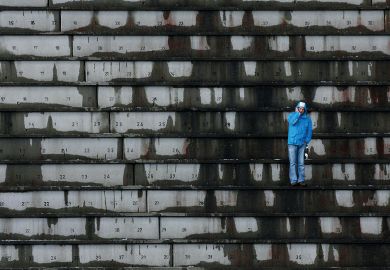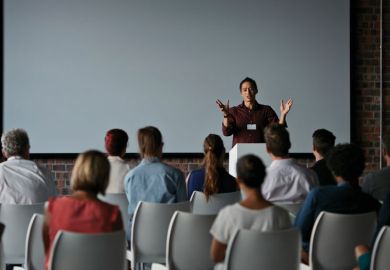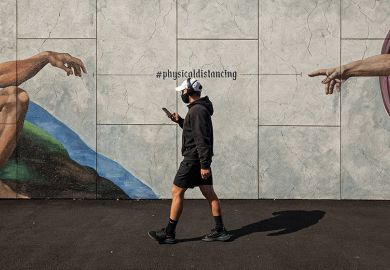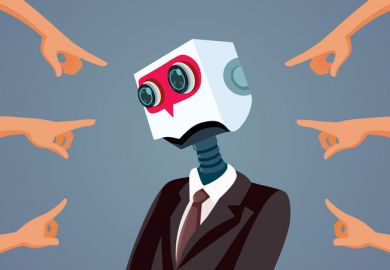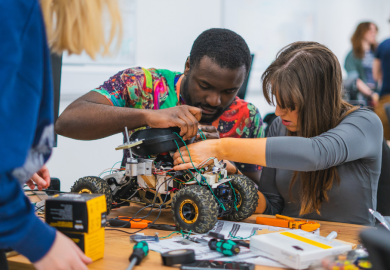When veterinary parasitologist Jan Slapeta gave his first regular lecture at the University of Sydney 15 years ago, he found the experience “intimidating”.
“There were 80 to 100 students looking at me, and I had to somehow perform and get the point across. It was not a one-off guest lecture, and I felt a responsibility to develop, in a sense, some sort of safe space where they felt comfortable to ask questions.”
This May, Professor Slapeta found himself disconcerted in a completely different way, when nobody showed up for a lecture. It was supposed to be his first in front of a new student cohort. Face-to-face lectures had only recently resumed at Sydney after a two-year Covid hiatus.
“I was told to give the lecture anyway, because some might be watching it streamed,” he subsequently explained in a tweet that went viral. “Fifty min discussion with chairs. Is this what uni is now?”
In August, the episode repeated itself, when no students presented for a 1pm lecture. “Should I be shocked again?” he tweeted. “Where [to] from now?”
Twitter rejoinders exhibited varying levels of sympathy. “Teaching is social and there is nothing like building knowledge together with students in a room,” one respondent contended. “Or make your lectures interesting enough that learners actually want to be there?” suggested another.
The exchange reflected an increasingly incongruous situation on campuses, with students and staff clamouring for the social contact they missed during Covid – yet often passing when it becomes available.
Sydney vice-chancellor Mark Scott captured the contradiction in a presentation to the National Press Club. “The in-person teaching experience – learning together – adds something vital and unique, [but] many of our students have to work long hours to support themselves,” he said.
“The sense of university as a place you want to spend as much time as you could has – even before Covid – been increasingly challenged. The convenience of a lecture that’s available online often seems a good enough reason to not attend in person.”
Professor Slapeta agreed. While students consider their “active participation” vital for workshops, lectures are something they can “watch later”. But this is more about the stereotype than the reality of most contemporary lectures, with the days long gone when students were forbidden from asking questions until the monologue on stage was over.
“I’ve gone through uni as well. Don’t ask me how many times I went to lectures. Some were terrible, but so were some practicals. There can be bad practicals, bad tutorials and bad lectures, but all of them can be absolutely fantastic,” he told Times Higher Education.
“For me, the lecture is just a bigger tutorial. People say the lecture is dead, but I think there’s still value in it when you want to get a certain concept across. I could give students some paper or chapter to read, but it takes time. I can probably help them to grasp that material more quickly. They can ask me questions, and we can get to the bottom of it. If that’s what a lecture is about, it’s not dead; it’s alive. It’s very alive.”
Professor Slapeta said modern lectures were peppered with interactive features such as quizzes administered using QR codes. Experiencing such things later is “like watching a tennis match where you already know who won”. And the oft-quoted phenomenon of students going to the campus bar or library, firing up their laptops and watching lectures in real time is “like going to a live concert and listening on Spotify”.
Professor Slapeta acknowledged the obvious advantages of online lectures. Students struggling with rising transport costs – or transport availability, particularly during a recent spate of Sydney train strikes – often made the “pragmatic” decision to attend from home. If they passed their units anyway, what was the harm?
But online delivery also denied lecturers access to subtle signs, such as body language cues, revealing whether students were absorbing the material. It denied students a natural opportunity to “debrief” after lectures. And for those reluctant to ask questions in class, over Zoom or even by email, it denied them the opportunity “to approach you when you’re walking out of the lecture theatre”.
“Students are unique, but our modalities are becoming too homogeneous,” Professor Slapeta said. “Because of Covid, it seems that online became the norm.” He said that when he organised an in-person practical during Covid lockdown to explain diagnostic tests that he felt could not be adequately illustrated remotely, many students had been reluctant to attend. But afterwards some had confided that they “did not want to leave because it was so valuable”.
Professor Slapeta said higher education had “moved so quickly” into the online world over the past 30 months, but it still needed to find its feet. “Not to give up on it, absolutely not, but to find the right balance.”
He said novice lecturers starting out today faced a far more daunting prospect than his debut 15 years ago. “I was prepared for it. I was not prepared for zero. If I was a new lecturer now, turning up to my first lecture to find the hall empty, I would shit myself.”
POSTSCRIPT:
Print headline: ‘I came, I saw no students, I still lectured’
Register to continue
Why register?
- Registration is free and only takes a moment
- Once registered, you can read 3 articles a month
- Sign up for our newsletter
Subscribe
Or subscribe for unlimited access to:
- Unlimited access to news, views, insights & reviews
- Digital editions
- Digital access to THE’s university and college rankings analysis
Already registered or a current subscriber?


